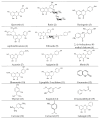Efficacy and Mechanism of Traditional Medicinal Plants and Bioactive Compounds against Clinically Important Pathogens
- PMID: 31835403
- PMCID: PMC6963422
- DOI: 10.3390/antibiotics8040257
Efficacy and Mechanism of Traditional Medicinal Plants and Bioactive Compounds against Clinically Important Pathogens
Abstract
Traditional medicinal plants have been cultivated to treat various human illnesses and avert numerous infectious diseases. They display an extensive range of beneficial pharmacological and health effects for humans. These plants generally synthesize a diverse range of bioactive compounds which have been established to be potent antimicrobial agents against a wide range of pathogenic organisms. Various research studies have demonstrated the antimicrobial activity of traditional plants scientifically or experimentally measured with reports on pathogenic microorganisms resistant to antimicrobials. The antimicrobial activity of medicinal plants or their bioactive compounds arising from several functional activities may be capable of inhibiting virulence factors as well as targeting microbial cells. Some bioactive compounds derived from traditional plants manifest the ability to reverse antibiotic resistance and improve synergetic action with current antibiotic agents. Therefore, the advancement of bioactive-based pharmacological agents can be an auspicious method for treating antibiotic-resistant infections. This review considers the functional and molecular roles of medicinal plants and their bioactive compounds, focusing typically on their antimicrobial activities against clinically important pathogens.
Keywords: antimicrobial activities; bioactive compounds; mechanisms; traditional medicinal plants.
Conflict of interest statement
The authors declare no conflict of interest.
Figures





References
-
- Kannaiyan M., Manuel V.N., Raja V., Thambidurai P., Mickymaray S., Nooruddin T. Antimicrobial activity of the ethanolic and aqueous extracts of Salacia chinensis Linn. against human pathogens. Asian Pac. J. Trop. Dis. 2012;2:S416–S420. doi: 10.1016/S2222-1808(12)60194-7. - DOI
-
- Kannaiyan M., Meseret Abebe G., Kanimozhi C., Thambidurai P., Ashokapuram Selvam S., Vinodhini R., Suresh M. Prevalence of extended-spectrum beta-lactamase producing enterobacteriaceae members isolated from clinically suspected patients. Asian J. Pharm. Clin. Res. 2018;11:364. doi: 10.22159/ajpcr.2018.v11i5.19363. - DOI
-
- Vijayakumar R., Aboody M., AlFonaisan M., Turaiki W., Mickymaray S., Mariappan P., Alsagaby S., Sandle T. Determination of Minimum inhibitory concentrations of Common Biocides to Multidrug-Resistant Gram-negative bacteria. Appl. Med. Res. 2016;2:56. doi: 10.5455/amr.20161012082036. - DOI
Publication types
LinkOut - more resources
Full Text Sources

